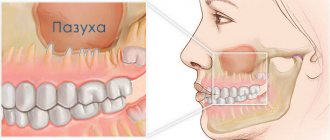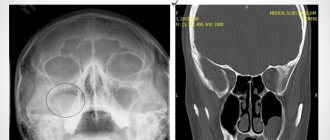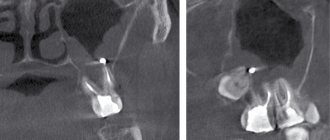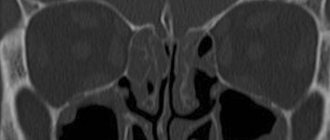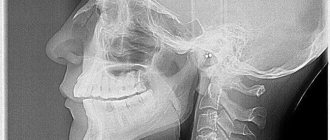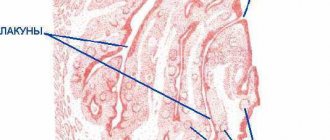A sinus cyst is a fluid-filled formation with elastic walls; the location of the cyst affects the symptoms of the disease. Most often, cysts form in the maxillary sinuses. The reasons for the development of cysts in the nasal sinuses are varied; there are a number of reasons for the appearance of a neoplasm:
- Blockage of the ducts of the mucus-secreting glands.
- Dental diseases, tooth roots protruding into the paranasal sinuses.
- Allergic diseases of the nose.
- Frequent inflammatory processes.
- Anatomical features of the structure of the nose.
- Mechanical injuries of the nose.
In the oncology department of the Yusupov Hospital, you can undergo examination using MRI, CT, ultrasound, diagnosis of diseases of the paranasal sinuses if a nasal tumor is suspected. The patient will be able to undergo a full examination at the diagnostic center, take tests in the hospital laboratory, and receive advice from an otolaryngologist, oncologist and other specialists.
Cyst in the sinus: symptoms and consequences
Sinus cyst, symptoms of the disease depend on the location of the cyst, there are false and retention. The cyst can increase in size and eventually block the sinus cavity. A false cyst in the sinuses can develop due to an inflammatory, allergic process, while a true cyst develops due to blockage of the ducts of the mucus-secreting gland. A cyst of the paranasal sinuses may not manifest itself as pronounced symptoms for a long time, then nasal congestion, headache, and soreness in the face, on the side of the affected sinus cyst, begin to bother you. The pain can intensify when diving, and inflammatory processes in the nose often develop.
As the cyst of the maxillary sinuses develops, it manifests itself in the following disorders:
- Constant nasal congestion.
- Respiratory dysfunction.
- Pain in the area of the sinus affected by the cyst.
- Unpleasant sensations and false symptoms of increased intraocular pressure.
- Severe headaches.
- Purulent discharge (concomitant development of sinusitis).
- Partial or complete loss of smell.
The consequences of cyst development are negative:
- A growing cyst provokes an inflammatory process and can lead to the development of sinusitis.
- Reduces the patient’s quality of life and causes constant severe headaches.
- A large sinus cyst can lead to destruction of nasal tissue, reach the nasopharynx, impair respiratory function, and deform the face.
- Some sinus cysts can develop into a malignant tumor.
Classification
The classification of maxillary sinus cysts is based on the factor of their origin and secondary changes in the sinus , which is due to the specific treatment of each form and the need for surgery. Based on the mechanism of occurrence and morphological characteristics, they distinguish:
- True (retention) cysts. They are formed as a result of complete/partial obstruction of the excretory ducts of mucus-producing glands. They have an epithelial lining with columnar ciliated epithelium. The reasons for their obstruction are: swelling , blockage , scarring or hyperplasia . The gland continues to function and produce secretions. Over time, the walls stretch, it overflows and closes the lumen of the sinus.
- False cysts (cyst-like formations). They do not have an epithelial lining and are formed in the thickness of the mucous membrane.
- Odontogenic cyst (radicular/follicular). Filled with pus. Radicular cysts form around the root of the inflamed upper tooth, penetrating into the sinus by growing through the atrophied bone tissue of the upper jaw. Follicular cysts form directly from the follicle of a baby tooth.
- Congenital cysts. Caused by developmental defects (anomalies of the mucous membranes of the maxillary sinuses/deformations of the upper jaw), contributing to the formation of cysts.
Main sinus cyst: symptoms, treatment
A cyst of the main (sphenoid) sinus develops more often in young people and rarely in older people. The cavity of the main sinus of the nose is covered with mucous membrane. The sheath glands secrete mucus; disruptions in functioning lead to blockage of the gland ducts and the formation of a cyst of the sphenoid sinus. Inflammatory processes, injuries, and allergic reactions have a negative effect on the mucous membrane. A growing cyst of the sphenoid sinus is accompanied by a feeling of fullness in the nose, nausea and dizziness may occur, a headache that radiates to the back of the head, and visual disturbances rarely develop.
If a sinus cyst is detected, treatment is carried out after a complete examination. The doctor prescribes diagnostic tests for the patient using:
- X-rays to determine the location of the cyst, changes in the condition of the facial bones and nasal septum.
- Magnetic resonance imaging, which determines the condition of the skull bones, tissues, and blood vessels. A more informative study than radiography. Computed tomography has the same capabilities. Research is carried out as prescribed by a doctor.
- Research using an endoscope allows you to examine the nasal cavity and perform a biopsy of nasal tissue.
After the studies, conservative or surgical treatment may be prescribed. Conservative treatment is aimed at pain relief, relieving an allergic reaction, and treating the inflammatory process. If conservative treatment is ineffective or the cyst is large, the patient is referred for removal of the formation.
Diagnostics
Figure 1. Cyst in the maxillary sinus.
Source: Contemporary clinical dentistry / Open-i (Attribution-NonCommercial-ShareAlike 3.0 Unported) Before surgery to remove a sinus cyst, you need to take tests (for HIV, syphilis, hepatitis B and C, general blood test).
Usually, to make a diagnosis, the doctor only needs to collect an anamnesis and a general physical examination, including the nose.
Other diagnostic tests include:
Endoscopy of the nose. The doctor performs a detailed examination of the nose and sinuses using a narrow tube with a lighted magnifying lens or small camera.
Visualization methods. Images obtained from a computed tomography (CT) scan can help the doctor accurately determine the size and location of cysts in the deeper areas of the sinuses, and assess the degree of swelling and inflammation.
Test for cystic fibrosis. If a child needs diagnosis, the doctor may suggest testing for cystic fibrosis. This is an inherited disease that affects the glands that produce nasal mucus, tears, sweat, saliva and digestive juices. This is usually a non-invasive sweat test that can determine whether your sweat is more or less salty than most people.
Removal of sinus cyst without surgery
If a sinus cyst is detected, treatment without surgery is carried out using decongestant sprays, antibiotics, painkillers, mucolytics, steroids and antihistamines. They treat concomitant diseases - allergies, sinusitis, inflammatory processes of the gums, teeth, nasal mucosa. In combination with these drugs, various means for rinsing the nasal cavity, regenerating and restorative sprays are used. Treatment is prescribed by the doctor based on the results of the patient’s examination.
How to treat pathology
Treatment of the disease involves surgery. It is impossible to get rid of cystic formation with the help of medications and folk remedies. In some cases, radical surgery is not performed, observation is prescribed, and in some cases, auxiliary treatment methods are prescribed.
Types of surgery
There are several types of operations that are used to remove cystic formations. Most often, endoscopic surgery and gentle opening of the upper jaw through the anterior wall are prescribed.
| Type of operation | Advantages and disadvantages | How is the operation performed? |
| Endoscopic intervention | The main advantage is the low invasiveness of the operation, and dangerous complications rarely occur. The disadvantage is that not all cysts can be removed endoscopically. | The procedure does not require anesthesia. No incisions are made on the skin; instead, a special device is inserted into the nasal cavity through a natural opening, and then a special device is inserted into the sinus and the cyst is removed. |
| Opening through the front wall | The main advantage is the ability to remove large formations. Disadvantages include high morbidity and the need to use anesthesia. | Access to the sinus is gained through an incision in the anterior wall of the sinus. The cystic formation is removed, and if necessary, the anastomosis is expanded. |
Indications for removal of a maxillary sinus cyst
Surgery is the only effective treatment method. What are the indications for surgery:
- the diameter of the formation is more than 1 cm;
- progressive growth;
- suppuration;
- facial asymmetry;
- pronounced clinical symptoms.
If there are no indications for surgery, observation is prescribed. For concomitant diseases of the oral cavity, additional treatment is indicated - tooth extraction, antibacterial therapy.
Cyst in the sinus: surgery, reviews
Patient reviews give preference to the endoscopic method of cyst removal. When performing the classical method and laser vaporization, an incision is required under the upper lip to gain access to the cyst. Classic removal of a sinus cyst involves dissection of the soft tissue under the upper lip from the frenulum to the first molar (Caldwell-Luc method) or using the Denker method, which is also carried out through the facial part. Classic operations are more traumatic, with long postoperative recovery, but these techniques allow you to gain access to a cyst located in a hard-to-reach place. Endoscopic removal is carried out using an endoscope, the cyst is removed through a small burr hole, the operation is performed under local anesthesia.
At the Yusupov Hospital, patients will be able to undergo a full examination using modern diagnostic equipment. The hospital hosts doctors from various fields, there is a clinical laboratory, and a rehabilitation center. In the hospital you can recover from surgery or illness, and patients have a 24-hour inpatient facility.
Treatment of maxillary cysts
There are no conservative methods for treating cystic formations in the maxillary sinus. The doctor chooses one of the options for surgical intervention, which depends on the type of cyst, its location, the professional qualities of the specialist and the individual characteristics of the patient.
In modern medicine, the following operations are widely used to treat cysts:
- Open surgery. A manipulation that involves general anesthesia and has many complications and risks. The anterior wall of the maxillary sinus is opened, and the cyst is removed through the resulting hole. The main problem is the overgrowing of the access with scar tissue. This completely contradicts the physiology of the body and does not allow sinus lifting and dental implantation in this area in the future.
- Endoscopic treatment. One of the most advanced and successful in modern medicine. Using a special instrument, the doctor enters the maxillary sinus through its natural opening without damaging the bone tissue. The cyst is then sucked out or desquamated.
- Classic removal. A typical open sinus lift approach is performed, through which the cyst is removed. The operation is performed in cases where the cause of the development of the formation is a diseased tooth.
Since cystic formations are most often discovered during the preliminary examination for sinus lift, the doctor must choose a treatment method that will not interfere with further bone grafting. The final decision always belongs to the patient, so he needs to be told the advantages and disadvantages of each therapeutic technique.
Possible complications
Since this formation is not malignant and does not form metastases, it does not lead to disruption of the functions of other organs. Only a large tumor can lead to complications.
If the cyst has been damaged, then there is a chance of contracting ENT diseases, infections, purulent infection of oral tissues, bones, and also the loss of several teeth. Otherwise, with proper treatment and recovery process, the risk of relapse is minimal.
Could she burst?
If the size is significant and there is overload in this area, the tumor may burst. The liquid will begin to flow out and cause inconvenience.
Computer 3D diagnostics - for reliable results
Ultra-modern SIRONA-SIEMENS tomograph with ENT settings - ultra-precise and safe search for hidden odontogenic and ENT pathologies
- Highly accurate assessment of the condition of teeth and maxillary sinuses
- Detection of the extent of the inflammatory process, location and size of the cyst
- Analysis of efficiency and forecast of ongoing operations
Conservative treatment: when possible
Conservative treatment is only possible for small root cysts. At this time, the canals of the tooth are treated, on the roots of which a cyst has formed. The treatment consists of thorough cleaning and filling of the dental canals and is carried out under a microscope, which ensures the accuracy of all manipulations and allows you to find all the canals in the tooth and fill them. Most often, after endodontic treatment, the cyst disappears, which is recorded on an x-ray taken a few weeks after the operation.
Alveolar cyst
We are talking about odontogenic neoplasms that are localized in areas near the alveolar bay. The negative impact of such a cyst, if left untreated, can damage the root system of the upper teeth. It can only be removed through surgery.
Maxillary sinus cyst
This variety practically does not manifest itself in any way. Only with a certain location and significant size can it lead to pain.
Most often, it is discovered by chance when the doctor suspects another disease. To do this, a CT, MRI, or x-ray is performed in the area of the maxillary sinus.
Dimensions
The size of the cyst does not affect the severity of symptoms. Large formations may not cause inconvenience. It is much more important where exactly the tumor is located :
- Those located in the lower section of the sinus cause less discomfort.
- But even a small formation located in the upper wall can lead to complications and headaches.
This is due to the close location of the cyst to the branches of the trigeminal nerve.
Recording of a webinar from a doctor of sciences on the topic:
Danger of maxillary sinus cysts
The insidiousness of the disease is its asymptomatic course in the early stages, which means late access to a doctor. Without high-quality diagnosis and adequate treatment, the cyst grows, in the process absorbs the sinus mucosa, changing its density and structure, and over time “corrodes” the surrounding bone tissue. When it grows, it blocks the air passages, complicates breathing, there is a risk of abscesses, phlegmon, bone deformation or jaw fracture.
An overgrown cyst disrupts the functions of the paranasal sinuses and poses a serious danger:
- blockage of the mucus ducts between the maxillary sinuses and the nasal cavity provokes the development of a severe form of purulent sinusitis, which is difficult to treat
- Impaired breathing functions lead to oxygen starvation, chronic fatigue, decreased brain activity and concentration
- the pressure of the neoplasm on the nerve endings of the sinus mucosa is accompanied by constant headaches and migraines
- an increase in pressure on the bones of the skull is accompanied by deformation of bone structures, spontaneous fractures of the jaw are possible
- when affecting the visual organs, orbital complications, visual impairment, and double image may develop
- the cyst shell may burst, leaking purulent fluid leads to infection and tissue necrosis, abscess, phlegmon, meningitis, encephalitis
Consequences of deletion
For successful recovery after removal of the cyst, the patient is hospitalized. It lasts no more than 2 weeks:
- Every day the nose and sutures are treated and washed with an antiseptic.
- The patient takes antibiotics (broad-spectrum), antihistamines and, if necessary, painkillers.
- The patient will be offered to undergo a course of physical treatment aimed at resolving the swelling.
If the incision heals at a normal pace, the stitches will be removed after 7 days. But in general, rehabilitation will take up to 4 weeks.
During this period, the patient must follow a number of rules :
- Maintain oral and nasal hygiene.
- Rinse your mouth with plain water every time after eating.
- Do not pick your nose or put your fingers in your mouth.
- Reduce physical and thermal stress on the body. Therefore, stop playing sports for a while, do not bathe in hot water, and do not eat hot and spicy foods.
Important! At first, swelling of the lips and cheeks, numbness, and poor sensitivity in this area may persist. It happens that the sense of smell deteriorates for a while, breathing through the nose becomes difficult, and discharge appears. This is a temporary post-operative effect that will go away within a week.
Comments
The other day I visited LORA, because... I'm worried about constant nasal congestion. HE examined and diagnosed “odontogenic sinusitis” and prescribed symptomatic treatment. He said that in order for everything to return to normal, you need to go to the dentist and look for the cause. No cyst was found. Explain what could be the reason and why this is dangerous?
Tanyusha (06/03/2020 at 17:53) Reply to comment
- Dear Tanyusha, the diagnosis of odontogenic sinusitis indicates that the problem should be looked for in the oral cavity. The cause of its development is often periodontitis, perforation of the sinuses during dental treatment, impacted and dystopic teeth. If the exact cause is not identified and eliminated, then the formation of a cyst will not take long to occur.
Editorial staff of the portal UltraSmile.ru (06/08/2020 at 09:16) Reply to comment
Hello. Today I had an MRI about pain on the right side of my face. A cyst was discovered in the maxillary sinus on the right. Tell me where to run and what to do? Thank you.
Victoria (08/17/2021 at 04:57 pm) Reply to comment
